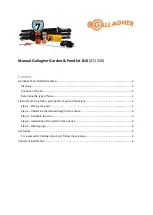
022519
TABLE OF CONTENTS
1. DESCRIPTION
1.1 ANSI and OSHA
2. APPLICATION
2.1 Purpose
2.2 Personal Fall Arrest
2.3 SRD Orientation In Fall Arrest
2.4 Rescue
2.5 Application Limits
3. SYSTEM REQUIREMENTS
3.1 Capacity
3.2 Compatibility Of Connectors
3.3 Compatibility Of Components
3.4 Making Connections
3.5 Personal Fall Arrest System
3.5.1 Average Arrest Force and Arrest Distance
3.6 PFAS Anchorage Strength
3.7 Definitions
4. INSTALLATION AND OPERATION
4.1 Plan the Personal Fall Arrest System
4.2 Anchorage
4.3 Minimum Required Fall Clearance
4.3.1 Overhead (Above the D-ring) Anchorage Condition
4.3.2 Non-Overhead (Below the D-Ring) Anchorage Condition
4.4 Swing Fall
4.4.1 Overhead Anchorage and Swing Fall
4.4.2 Non-Overhead Anchorage and Swing Fall
4.5 Installation And Use Of The SRD
4.5.1 Housing End Attached To The FBH
4.5.2 Housing End Attached To The Anchorage
4.6 Locking Speed
4.7 Impact Indicator
5. SPECIFICATIONS
6. MAINTENANCE, SERVICE AND STORAGE
6.1 Maintenance
6.2 Service
6.3 Storage
7. INSPECTION
7.1 Before Each Use
7.2 Inspection Frequency
7.3 Inspection Checklist
7.4 Inspection Results
7.5 Inspection Document
8. LABELS
APPENDIX A –
Table 1A, 1B, 1C, , Table 2, Table 3, Table 4, Chart 1,
Figures 1 – 7
APPENDIX B –
Figures 1 – 13, Acronyms and Abbreviations,
Inspection Record
1. DESCRIPTION
The FallTech® DuraTech™ 9' Cable SRD is a self-retracting lifeline for those working at height and subject to fall hazards.
This manual contains two Appendices, Appendix A and Appendix B. Appendix A contains figures and tables specific to the SRD discussed in this
manual. Appendix B contains figures and tables applicable to fall protection equipment in general. All figure, table, and chart references in this
manual are to Appendix A unless otherwise noted. All paragraph and section references are to this manual unless otherwise noted. The user of the
equipment discussed in this manual must read and understand the entire manual before beginning work.
For purposes of this manual, the SRD may be referred to as the SRD, the equipment, the device, the product, or the unit. The terms galvanized wire
rope and steel cable are used interchangeably.
At the top of the unit, a swiveling steel eye provides an attachment point for a self-closing and self-locking connector. The SRD body consists of a
nylon housing containing a 9' length of galvanized or stainless steel wire rope wound onto a spring-tensioned drum. The drum is equipped with a
pawl system that engages a brake on the drum, slowing and halting lifeline payout to arrest the fall in a fall event. The leg end of the cable is
equipped with a wound spring retracting shock absorber, with a rubber handle over the double clamps of a thimble eye. The leg end connector
may be one of a variety of connectors. See Tables 1A – 1C, and Figure 1.
The safe working lifeline length of the SRD is 9'. A certain amount of lifeline must always remain on the SRD drum to ensure proper brake function.
The lifeline is equipped with colored working length line indicators. See Section 4.
When attached and the worker moves about, the lifeline pays out and retracts, automatically maintaining a taut line.
The SRD is not designed for Leading Edge applications. Do not use the SRD where a Leading Edge hazard is present.
1.1 OSHA Regulations and ANSI Standards:
The device discussed in this manual complies with OSHA 1926.502 regulations. The device also
complies with ANSI standards Z359.14. Z359.14 sets performance requirements for SRDs, based on dynamic testing. There are two classifications;
Class A, and Class B. The SRD discussed in this manual has been tested in accordance with ANSI Z359.7, and conforms to ANSI Z359.14 standards for
a Class B device. These tests include Dynamic Performance Testing, Dynamic Strength Testing, Static Strength Testing, and Retraction Tension
Testing. See paragraph 3.5.1.
2. APPLICATION
2.1 Purpose:
An SRD is designed for use as a component in a PFAS, to provide a combination of worker mobility and fall protection as required for
inspection work, general construction, maintenance work, oil production, confined space work or any application where fall protection and worker
mobility is required. The SRD is not designed nor suited for use in restraint, personnel riding, suspension, work positioning, or rescue applications.
Do NOT use the SRD for these applications except as part of a back-up PFAS.
2.2 Personal Fall Arrest System:
A PFAS is typically composed of an anchorage and a FBH, with an energy absorbing connecting device, i.e., an SAL,
an SRD, or a Fall Arrester Connecting Subsystem (FACSS), attached to the dorsal D-ring of properly fitted and adjusted FBH. All uses and
applications of a FBH with this equipment requires the FBH to be properly fitted and adjusted to the user. Failure to properly fit the FBH to the user
could result in serious injury or death.
The SRD may be installed on a FBH, or attached to a suitable anchorage. See Section 4 for additional details.
2.3 SRD Orientation In Fall Arrest:
The 9' Cable SRD is designed for use in either of two configurations;
•
With the housing end installed on the dorsal D-ring of a properly adjusted and fitted FBH. The leg end is connected to an anchorage, which can
range from overhead (above the D-ring) to non-overhead (up to 2' below the D-ring). See Figure 2A.
•
With the housing end attached to a suitable anchorage, which can range from overhead (above the D-ring) to non-overhead (up to 2' below the
D-ring). The leg end is connected to the dorsal D-ring of a properly adjusted and fitted FBH. See Figure 2B.



































